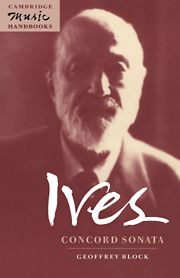4 - Form and design
Published online by Cambridge University Press: 10 December 2009
Summary
Like other modernists, Ives endeavored to create an idiosyncratic and compelling musical response to the competing aesthetic and technical principles that marked the end of the nineteenth century and the early decades of the twentieth. Thus, despite such prominent signs of modernism as pervasive atonality and dissonant counterpoint, Ives's Concord Sonata might also be viewed as a continuation rather than a retreat from the musical ideals of an earlier era. Just as Beethoven had explored the boundaries of classical sonata form and style without abandoning its fundamental ideologies, so Ives stretched and reinterpreted the nineteenth-century European and American traditions.
Although Ives called his Concord Sonata and other multi-movement works for piano (or violin and piano) a sonata “for want of a more exact name,” a common thread of techniques among the works so designated reveals that Ives did, in fact, distinguish between sonatas, “sets,” and other descriptive experimental works with or without programmatic titles. For Ives, as for other nineteenth–century composers who followed in Beethoven's wake, the appellation “sonata” meant a substantial and usually serious–minded multi–movement or multi–sectional composition in a tradition that could accommodate works as different as Liszt's B minor Piano Sonata or the formally more conservative chamber sonatas of Brahms.
In common with other historically important compositions, including non-sonatas such as Schubert's Wanderer Fantasy for piano and the operas of Wagner, works that Ives chose to designate as sonatas borrowed freely from the ubiquitous nineteenth-century techniques of cyclic form, thematic transformation, and the development of motivic families. Less typically for an extended piano work, Ives's Concord Sonata also contains considerable programmatic content.
- Type
- Chapter
- Information
- Ives: Concord SonataPiano Sonata No. 2, pp. 31 - 46Publisher: Cambridge University PressPrint publication year: 1996



